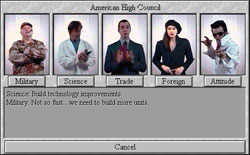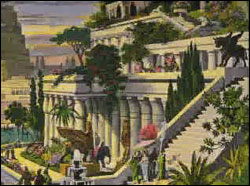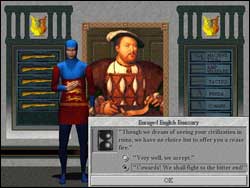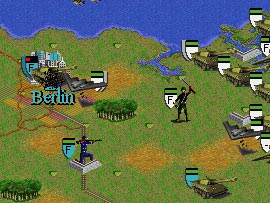 This interview is a "deleted scene" of sorts from Sid Meier’s
This interview is a "deleted scene" of sorts from Sid Meier’s
Civilization Chronicles, the definitive Civilization collector’s
edition. As part of this project, several interviews with members of
past Civilization teams were conducted by journalist Troy Goodfellow.
These were used as the source material for a massive article on the
history of the franchise that is include in a 96 page book included in the Civ Chronicles package.
This interview is with Brian Reynolds, the lead designer on Civilization
II. Brian was also the lead designer at Firaxis Games on Alpha Centauri
before leaving to found Big Huge Games, the creators of Rise of Nations
and its recent sequel Rise of Legends.
Sid Meier’s Civilization Chronicles for PC will be released this October
for a MSRP of $69.99. More information is available on http://www.civilization.com.
Why did you decide to remake Civ? Was there any resistance to the idea?
 That was an interesting set of decisions because at the time the “right answer” of what if anything to do with the Civ franchise was far from obvious. Up to that point, no one had successfully “sequelized” one of Sid’s strategy games (there had been follow-on attempts for both Pirates and Railroad Tycoon which hadn’t panned out). The closest we’d come was with Colonization in 1994 which wasn’t really a sequel but clearly borrowed Civ elements, and was successful enough to encourage us to try for a full sequel; also in terms of my own involvement I think Colonization also helped give management confidence that I could do the work. But, much of the popular thinking at the time was that Civilization really just needed multiplayer support, not any more design or redesign (and to be fair, you can see why in 1991 it might have seemed that Civilization was “the perfect game” why would anyone want to redesign it?)—in fact, a project called CivNet was started around the same time, featuring Civ I gameplay with multiplayer rules.
That was an interesting set of decisions because at the time the “right answer” of what if anything to do with the Civ franchise was far from obvious. Up to that point, no one had successfully “sequelized” one of Sid’s strategy games (there had been follow-on attempts for both Pirates and Railroad Tycoon which hadn’t panned out). The closest we’d come was with Colonization in 1994 which wasn’t really a sequel but clearly borrowed Civ elements, and was successful enough to encourage us to try for a full sequel; also in terms of my own involvement I think Colonization also helped give management confidence that I could do the work. But, much of the popular thinking at the time was that Civilization really just needed multiplayer support, not any more design or redesign (and to be fair, you can see why in 1991 it might have seemed that Civilization was “the perfect game” why would anyone want to redesign it?)—in fact, a project called CivNet was started around the same time, featuring Civ I gameplay with multiplayer rules.
I think most of the company’s management sincerely believed that CivNet was going to be a much more important product than a solo-only sequel and that the so-called “Civilization 2000”, our working title for Civ 2 at the time, was just a weird idea “cooked up by Brian and Jeff” which they let us try partially because Sid thought it was a good idea and partially because they wanted to find something for me to do while I was living in England during my wife’s teaching fellowship. Management doubts about the product continued throughout the entire development cycle—first most of the marketing resources were diverted to CivNet, and then later to other Spectrum Holobyte products like Top Gun. At one point the CEO told us that our lifetime sales projection for the product was something like 38,000 units, which I guess explains why they spent nearly nothing on marketing the game in its first 6 months. In my own mind, I was “hoping for 350,000” which is about what we’d sold of Colonization (profitable for its day). Needless to say even the most optimistic of us weren’t predicting the multimillion breakout hit that we actually got.
But all of that “management perspective” is only half the story! The reason the Strategy Group (as we called ourselves internally in those days) was excited about doing a Civ sequel is because it was the game to which we were all (still) addicted and we all had our own ideas about how we’d love to tinker with it. For myself I’d been playing Civ I since my first 2am encounter with it during beta, and before that I’d played and hack-modded Empire all through college, so I was thoroughly steeped in the lore of just-one-more-move 4X games even before I “wrote one” in the form of Colonization. I knew for example that I wanted to tinker with the diplomatic AI and give it more variety, and that we ought to do some things to improve combat (Battleship-killed-by-Phalanx was a classic player complaint about Civ I) but it didn’t become clear until later just what about combat should change. In the end we approached the gameplay in the style Sid had taught us – get it running early, and do lots of playing and prototyping. From a “cold start” in September 1994, we were playing games using a combination of Civ 1 and CivNet art by March 1995, and then most of the real gameplay innovations all happened between March and September 1995. In the core gameplay I think the most significant additions were the combat changes, a completely re-written AI for all levels of the game, more detailed diplomacy, and then of course the addition of new units, buildings, and technologies.
I also wanted to work on the interface of the game and make it more GUI-oriented. A lot of people forget this, but the decision to make Civ 2 a “windows game” was a risky move at the time, but paid off big time. It was kind of a labor of love to go above and beyond the minimum of getting the game running under Windows and make it truly a “Windows friendly” game with resizeable subwindows on your desktop and so forth—and for this I owe much inspiration to the CivNet guys who were evangelists of this sort of thing. The fact that Civ 2 came out right after Windows 95 was adopted, and “ran well on anything” is I think a little-appreciated fact in its success. These days the graphics card manufacturers have led us back down the garden path of hardware/driver incompatibilities to the point where many players have such a hard time getting Windows games to run on their systems that they give up and go play console games—but for a brief and shining moment there was Windows 95 which gave PC-owners the closest thing they ever had to a stable gaming platform. I’m certain this played a significant role in Civ 2’s success.
Ultimately Civilization II was a very difficult game to “demo” even to someone familiar with the series—they would just look at it and say “but isn’t this just Civ 1 with better graphics”? It was hard to point to one landmark feature and say look here’s the new revolutionary thing—there was just this combination of lots of little small things, and the fact that they all fit together perfectly, and that’s really hard to communicate without someone sitting down and playing the game for a few hours, which is ultimately how the product became successful: word-of-mouth and “viral” marketing. It wasn’t that any one revolutionary feature was the thing that made Civ 2 great; if I absolutely had to pick one thing maybe I’d say being Windows-friendly, because it was truly the first big game to do a good job of that, but really I think it was the fact that Civ 2 was a polished product – a very very polished product in fact.
How did working in England affect the development of Civ 2?
Well first of all I think there’s a strong chance that there’d never have been a Civ 2 if Jill hadn’t gotten the Fullbright. When I told my bosses that my new wife was going to be living in England and one way or the other I was going to go with her, I’m happy to say they didn’t just tell me “well it’s been nice knowing ya”. For whatever reason they thought it was worthwhile to find me a project I could work on semi-independently. I was certainly known as a good solo-programmer at the time, and I’d had some design experience co-designing Colonization with Sid, but I think management was looking for something with enough inherent structure that I wouldn’t be in as much danger of heading completely off into outer space with the design. So the “Civilization 2000” idea turned out to fit that idea nicely, and sounded like a dream project to me, to boot – imagine going off to live in a foreign country for a year, with a license to tinker to your heart’s content with your favorite game of all time? Oh, and with barely any supervision as long as builds were showing up every now and then! That was certainly some “out-of-the-box thinking” on the part of my bosses, though I suppose as a one-programmer-show I wasn’t all that expensive for them to take a flyer on.
Truly I think working on the project in England was probably one of the best things that could have happened to the game – because during the week while my wife was at work or preparing for class there was truly nothing to do but tinker endlessly with the game. The telephone never rang, nobody stopped by the office to ask a question about something “important” but distracting, nobody wanted to go to lunch, nobody wanted to goof off and play Magic: The Gathering, nobody wanted to divert me to work on little side projects for other products. There was no internet and just barely any such thing as e-mail. Just me, the computer, and the game.
I can remember the very first morning thinking “uh oh, I’d better find somewhere to get started” and I spread graph paper out all over our tiny little living room and spent the morning playing with the tech tree (my single favorite part of Civ when it first came out) to see how much room there was to expand it while keeping the history and pacing straight—I can remember specifically thinking “let’s see if we can connect up all the ‘early-dead-end’ technologies like Horseback Riding”. And from there it was just layer after layer of adding little cool things here and there, until August of 1995 when we came home. From that point we had about 6 months to ship the game, and this was the time when most of the art, multimedia, and other aspects of the game were added.
How did you find the advisors for the animated council? Why do it that way in any case?
 At the time Microprose had created a “multimedia department” featuring Michael Ely, Tim Train, and Jason Coleman, with the idea being to find ways to get better movies and visuals into the games. These guys had already done some really cool film stuff for a “Colonization Gold” edition which sadly never saw the light of day, and we decided that multimedia was a good cost-effective way to get some pizzazz into the game. I don’t actually remember where we came up with the actors for those things, but I thought they had a great Civ flavor.
At the time Microprose had created a “multimedia department” featuring Michael Ely, Tim Train, and Jason Coleman, with the idea being to find ways to get better movies and visuals into the games. These guys had already done some really cool film stuff for a “Colonization Gold” edition which sadly never saw the light of day, and we decided that multimedia was a good cost-effective way to get some pizzazz into the game. I don’t actually remember where we came up with the actors for those things, but I thought they had a great Civ flavor.
 On the subject of the multimedia guys, they also deserve credit for what I thought was the single best audio-visual idea for the entire product: Wonder Movies. Those little Ken-Burns-style pan-and-scans and footage clips made great payoffs when players completed wonders, and they fit perfectly with the importance in the game for wonders. So often games will reward players with great audio visuals for doing almost nothing, or players will struggle against a mighty challenge and see little payoff. I thought the wonder movies were perfectly balanced in being a nice payoff for a significant undertaking, and they came at a reasonable pace and fit aesthetically with the game story as well! On top of that they were cheap cheap cheap to produce! Mostly we licensed stock footage and photos and relied on the editing talents of the multimedia guys, who also put in some of the latest nights of the team because they had to babysit the Premiere program that compiled the movies.
On the subject of the multimedia guys, they also deserve credit for what I thought was the single best audio-visual idea for the entire product: Wonder Movies. Those little Ken-Burns-style pan-and-scans and footage clips made great payoffs when players completed wonders, and they fit perfectly with the importance in the game for wonders. So often games will reward players with great audio visuals for doing almost nothing, or players will struggle against a mighty challenge and see little payoff. I thought the wonder movies were perfectly balanced in being a nice payoff for a significant undertaking, and they came at a reasonable pace and fit aesthetically with the game story as well! On top of that they were cheap cheap cheap to produce! Mostly we licensed stock footage and photos and relied on the editing talents of the multimedia guys, who also put in some of the latest nights of the team because they had to babysit the Premiere program that compiled the movies.
Those Wonder movies were so great that I really pushed hard to get them included in Alpha Centauri as well – it just seemed like too much of a step backward not to include wonder movies, plus they were so helpful in creating a feeling of depth to the science fiction world of the game. But there wasn’t exactly a lot of stock footage available for science fiction scenes (we did manage to license some footage from Baraka like that chickens-down-the-conveyor-belt scene), so they were quite expensive, and I’m not all that surprised the concept was dropped from Civ3 – it probably just got too expensive, although I’d love to see the old Civ2-style ones (or those movies exactly) included in a future edition as a minor flourish.
Civ II had more of everything – more civs, each with two leaders, new units, new techs…was “more” a philosophy going in?
 Yes actually it was. Most of us realize that “more” isn’t always better in game design & sequels, and indeed after a series of sequels it is easy for a game system to become so choked with features and materials that new players can’t actually understand it and even old ones are overwhelmed. But Civ2 was the first sequel in the series, so there was a lot of room to add new things, plus it had been 5 years since the game’s original release and the fans had developed a huge and well-thought-out wishlist (there was a Civ 2 wishlist in the USENET newsgroups at the time, and I got in touch with the list’s maintainer and traded e-mails for a while: there were some great fan ideas which we did indeed incorporate into Civ2). One of our guiding philosophies for Civ2 was to try to fill out areas which had been “sketched in broad strokes” in Civ1. This applied not only to the game design (e.g. adding health bars and related concepts to combat) but also to filling in additional unit and technology types which felt “missing”. In a similar vein we worked on what were perceived as gaps in the AI – for example the AI players actually built their Wonders and Caravans honestly (no more of the much-complained-about insta-cheating of wonders and caravans), they put serious effort into their space-races, players built up a “reputation” when treating other countries badly (so bullies didn’t get to start with a clean slate with each new victim), and the computer was less apt to fall for the “fortify a bunch of units right next to your capital city” ploy (the two-square “buffer zone” during peace-time which eventually evolved into the national borders in Alpha Centauri). Adding “more” isn’t always the right approach (and designers of future Civ installments may very well need to look for ways to add “less” or at least replace older things with newer things), but I think it was just right for Civ 2 given where the franchise was at the time. I think it was exactly what the fans were slavering for, and boy did they ever slaver.
Yes actually it was. Most of us realize that “more” isn’t always better in game design & sequels, and indeed after a series of sequels it is easy for a game system to become so choked with features and materials that new players can’t actually understand it and even old ones are overwhelmed. But Civ2 was the first sequel in the series, so there was a lot of room to add new things, plus it had been 5 years since the game’s original release and the fans had developed a huge and well-thought-out wishlist (there was a Civ 2 wishlist in the USENET newsgroups at the time, and I got in touch with the list’s maintainer and traded e-mails for a while: there were some great fan ideas which we did indeed incorporate into Civ2). One of our guiding philosophies for Civ2 was to try to fill out areas which had been “sketched in broad strokes” in Civ1. This applied not only to the game design (e.g. adding health bars and related concepts to combat) but also to filling in additional unit and technology types which felt “missing”. In a similar vein we worked on what were perceived as gaps in the AI – for example the AI players actually built their Wonders and Caravans honestly (no more of the much-complained-about insta-cheating of wonders and caravans), they put serious effort into their space-races, players built up a “reputation” when treating other countries badly (so bullies didn’t get to start with a clean slate with each new victim), and the computer was less apt to fall for the “fortify a bunch of units right next to your capital city” ploy (the two-square “buffer zone” during peace-time which eventually evolved into the national borders in Alpha Centauri). Adding “more” isn’t always the right approach (and designers of future Civ installments may very well need to look for ways to add “less” or at least replace older things with newer things), but I think it was just right for Civ 2 given where the franchise was at the time. I think it was exactly what the fans were slavering for, and boy did they ever slaver.
What role did scenarios have in Civ 2’s development and longevity?
The funny story about scenarios in Civ 2 is that one month before we were supposed to ship my supervisor told me “Stop working on the scenario stuff, we need to just cut that feature. You don’t have any scenarios done, there isn’t enough time, and it’s not an important-enough feature for you to spend time on at this point.” Well, he was right about us not having any scenarios done, but although we’d left it toward the end this was one of the things I wanted most of all for Civ2 to have. I had actually been doing a lot of work on the Map Editor for Civ2 for my own enjoyment, and I really wanted to put the editor to use and give players some templates to build from. Also all of my games had always had a lot of user-moddable data (you know, the rules.txt and later rules.xml stuff), because coming from a hacker tradition myself I knew how much players wanted to tweak around with the game rules (for years Sid called me “the guy who put Cheat on the main menu”, which I always wore as a badge of honor). So I’ll come clean and admit that in this case I did the exact opposite of what I was told—for the next two weeks I quietly worked on practically nothing but the scenario feature.
 I designed the WW2 scenario myself as a prototype, and then talked someone (I think it was Mick Uhl) into making the Rome scenario. That gave us enough scenarios to ship with a viable feature, and although the editor work was necessarily hurried we were able to get the basic concepts in. I’m actually quite proud of those two scenarios (and the map editor) because the subsequent history of the franchise was made possible in significant part by the mod-ability and scenario-ability of the initial release.
I designed the WW2 scenario myself as a prototype, and then talked someone (I think it was Mick Uhl) into making the Rome scenario. That gave us enough scenarios to ship with a viable feature, and although the editor work was necessarily hurried we were able to get the basic concepts in. I’m actually quite proud of those two scenarios (and the map editor) because the subsequent history of the franchise was made possible in significant part by the mod-ability and scenario-ability of the initial release.
Much of the “viral marketing” we got for Civ2 in the first year came from the power of the scenario & mod community. The mods & scenarios also made the Civ2 expansion packs possible, and these in turn kept the franchise going strong for the full five years until the release of Civ3 – you could still find Civ2 selling for a strong price in any game store right up until Civ3 shipped. Indeed, scenarios and modability are now cornerstones of the whole franchise – every Civ generation gets multiple X-packs and the modability just becomes more and more detailed. So truly I think the scenarios and modabilty have proven key not just to Civ2 specifically but to the whole Civ franchise (and I’ll happily take credit for defiantly taking the first step against orders, one of my last great feats of “commando programming”! J)
How would you evaluate the success of Civ 2 MP?
My opinion? Multiplayer has always been somewhat of an albatross around the neck for the Civ franchise – it’s vocally demanded by a small but influential group of players, but it appeals only to that same small group and is immensely expensive to create (in relation to what it costs to create the rest of the product). Even real time strategy games generally have many more solo players than online players, and that’s a game system that’s designed at its heart to work well in a multiplayer environment. Civ was from the beginning a game which was designed as the “ultimate solo game experience”; it had lots and lots of detail, interesting AI, and unending different choices to be made. But nothing about it was ever designed to work well in multiplayer (and my own experiences playing Empire hotseat-multiplayer in college didn’t give me great confidence in how manageable a multiplayer game of Civ would be).
Ultimately though lots of effort was expended in welding multiplayer onto the Civ design – the first CivNet in 1995 using the Civ 1 core gameplay, but when players started voting with their wallets it quickly became clear that what they wanted was an improved solo game design (Civ 2), not a multiplayer addition to Civ 1. We did actually have significant multiplayer code running in Civ 2 towards the end of the project, but it was clear we didn’t have time to get it done during our schedule (and in this case I did follow orders to stop working on it J), but following our core-team’s departure to found Firaxis the full multiplayer code for Civ 2 was destined to wait for another couple years. I don’t know how much was spent on developing the MP capability, so I couldn’t really say if it was a “success” or not, but I’m kind of guessing that it mostly made a good way to get a modest number of hardcore players to re-purchase the already-planned gold edition. In other words I suspect that most people who bought the MP Gold Edition were players who didn’t already have Civ 2 and were just buying it to get the complete product, but that having the MP capability also got some hardcore players to “re-buy”.
On my own team’s next product, Alpha Centauri, we also put multiplayer in at great expense of time and energy, but I really don’t think it did much for the ultimate success of the product, and if I had it to do over again I’d have spent all of that time making the solo play a lot better. I know the story of multiplayer-in-Civ-games has continued in Civ3 and Civ4 so obviously there are still some true believers out there, and I’ll leave others to tell how they think that’s playing out; for myself I love multiplayer games and ultimately that’s why I decided to try my hand at an RTS!
Brian Reynolds was the lead designer on Civilization II. He later was lead designer of Alpha Centauri at Firaxis Games before leaving to found Big Huge Games, the creators of Rise of Nations and its recent sequel Rise of Legends.
Troy Goodfellow is a freelance gaming journalist based in Maryland. He has been playing computer strategy games for almost twenty years and still vividly remembers the day Civilization appeared. His work is often found in Computer Games magazine. Troy keeps a blog devoted to strategy games at www.flashofsteel.com.
